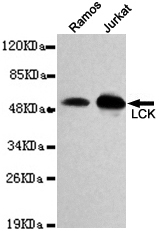-
Product Name
Anti-Lck (3E5) Mouse antibody
- Documents
-
Description
Lck (3E5) Mouse monoclonal antibody
-
Tested applications
WB
-
Species reactivity
Human
-
Alternative names
LCK;Lck p56;LCK_HUMAN;Leukocyte C-terminal Src kinase;LSK;Lymphocyte cell specific protein tyrosine kinase;Lymphocyte cell-specific protein-tyrosine kinase;Lymphocyte Specific Protein Tyrosine Kinase;Membrane associated protein tyrosine kinase;Oncogene lc antibody
-
Isotype
Mouse IgG1
-
Preparation
Antigen: Purified recombinant human LCK protein fragments expressed in E.coli.
-
Clonality
Monoclonal
-
Formulation
Purified mouse monoclonal in buffer containing 0.1M Tris-Glycine (pH 7.4 150 mM NaCl) with 0.02% sodium azide 50% glycerol
-
Storage instructions
Store at 4°C short term. Store at -20°C long term. Avoid freeze / thaw cycle.
-
Applications
WB: 1/1000
-
Validations

Western blot detection of LCK in Jurkat and Ramos cell lysates and using LCK mouse mAb (1:1000 diluted).Predicted band size: 58KDa.Observed band size: 58KDa.
-
Background
Swiss-Prot Acc.P06239.Non-receptor tyrosine-protein kinase that plays an essential role in the selection and maturation of developing T-cells in the thymus and in the function of mature T-cells. Plays a key role in T-cell antigen receptor (TCR)-linked signal transduction pathways. Constitutively associated with the cytoplasmic portions of the CD4 and CD8 surface receptors. Association of the TCR with a peptide antigen-bound MHC complex facilitates the interaction of CD4 and CD8 with MHC class II and class I molecules, respectively, thereby recruiting the associated LCK protein to the vicinity of the TCR/CD3 complex. LCK then phosphorylates tyrosines residues within the immunoreceptor tyrosine-based activation motifs (ITAM) of the cytoplasmic tails of the TCR-gamma chains and CD3 subunits, initiating the TCR/CD3 signaling pathway. Once stimulated, the TCR recruits the tyrosine kinase ZAP70, that becomes phosphorylated and activated by LCK. Following this, a large number of signaling molecules are recruited, ultimately leading to lymphokine production. LCK also contributes to signaling by other receptor molecules. Associates directly with the cytoplasmic tail of CD2, which leads to hyperphosphorylation and activation of LCK. Also plays a role in the IL2 receptor-linked signaling pathway that controls the T-cell proliferative response. Binding of IL2 to its receptor results in increased activity of LCK. Is expressed at all stages of thymocyte development and is required for the regulation of maturation events that are governed by both pre-TCR and mature alpha beta TCR. Phosphorylates other substrates including RUNX3, PTK2B/PYK2, the microtubule-associated protein MAPT, RHOH or TYROBP.
Related Products / Services
Please note: All products are "FOR RESEARCH USE ONLY AND ARE NOT INTENDED FOR DIAGNOSTIC OR THERAPEUTIC USE"
